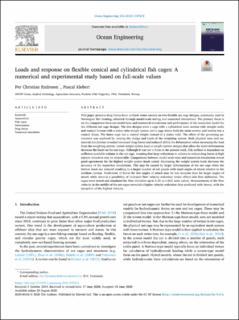| dc.contributor.author | Endresen, Per Christian | |
| dc.contributor.author | Pascal, Klebert | |
| dc.date.accessioned | 2021-02-21T13:21:10Z | |
| dc.date.available | 2021-02-21T13:21:10Z | |
| dc.date.created | 2021-02-19T12:51:35Z | |
| dc.date.issued | 2020-11-15 | |
| dc.identifier.citation | Ocean Engineering. 2020, 216 . | en_US |
| dc.identifier.issn | 0029-8018 | |
| dc.identifier.uri | https://hdl.handle.net/11250/2729336 | |
| dc.description.abstract | This paper presents drag forces from uniform water current on two flexible net cage designs, commonly used in Norwegian fish farming, obtained through model-scale testing and numerical simulations. The primary focus is on the comparison between model tests and numerical simulations and performance of the numerical model for the different net cage designs. The two designs were a cage with a cylindrical main section with straight walls and conical bottom with a sinker tube weight system and a cage where both the main section and bottom has a conical shape. The latter cage has a central weight instead of a sinker tube. The effect of the governing parameters was explored by varying the design and loads of the weighting system. Both physical tests and numerical simulations revealed increased drag forces and reduced ability for deformation when increasing the load from the weighting system. Lower weight system load or weight system designs that allow for more deformation decrease the loads on the net cage. Although it was not a focus in the present work, fish welfare is dependent on sufficient available volume in the net cage, meaning that large reductions in volume to reduce drag forces at high current velocities may be undesirable. Comparisons between model scale tests and numerical simulations reveal good agreements for the highest weight system loads tested. Decreasing the weight system loads decrease the accuracy of the numerical simulations. This may be caused by larger deformations of the net cage when the bottom loads are reduced resulting in a larger number of net panels with small angles of attack relative to the incident current. Predictions of forces for low angles of attack may be less accurate than for larger angles of attack while there is a possibility of increased flow velocity reduction (wake effect) and flow deflection. The cages were tested and simulated for flow velocities up to 1.25 m/s (full scale value). Measurements of the flow velocity in the middle of the net cages revealed a higher velocity reduction than predicted with theory, with the exception of the highest velocity. | en_US |
| dc.language.iso | eng | en_US |
| dc.publisher | Elsevier Ltd | en_US |
| dc.rights | Navngivelse 4.0 Internasjonal | * |
| dc.rights.uri | http://creativecommons.org/licenses/by/4.0/deed.no | * |
| dc.subject | Aquaculture | en_US |
| dc.subject | Fish cages | en_US |
| dc.subject | Deformation | en_US |
| dc.subject | Drag forces | en_US |
| dc.subject | Numerical simulation | en_US |
| dc.title | Loads and response on flexible conical and cylindrical fish cages: A numerical and experimental study based on full-scale values | en_US |
| dc.type | Journal article | en_US |
| dc.type | Peer reviewed | en_US |
| dc.description.version | publishedVersion | en_US |
| dc.rights.holder | © 2020 The Authors. Published by Elsevier Ltd. | en_US |
| dc.source.pagenumber | 12 | en_US |
| dc.source.volume | 216 | en_US |
| dc.source.journal | Ocean Engineering | en_US |
| dc.identifier.doi | 10.1016/j.oceaneng.2020.107672 | |
| dc.identifier.cristin | 1891745 | |
| cristin.ispublished | true | |
| cristin.fulltext | original | |
| cristin.qualitycode | 1 | |

